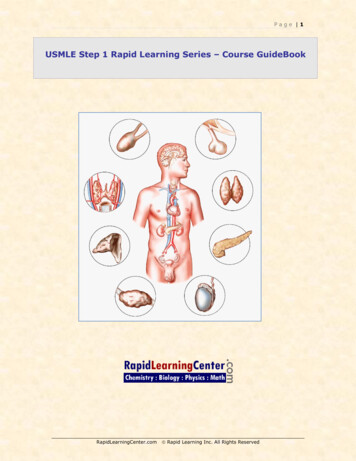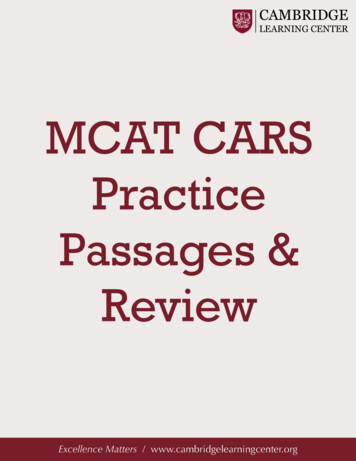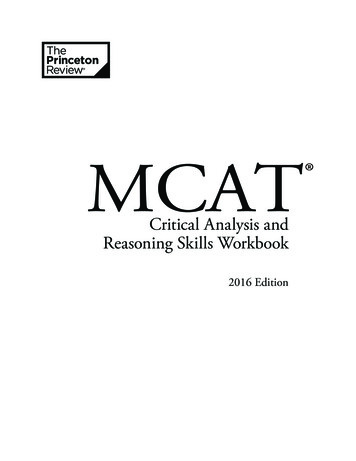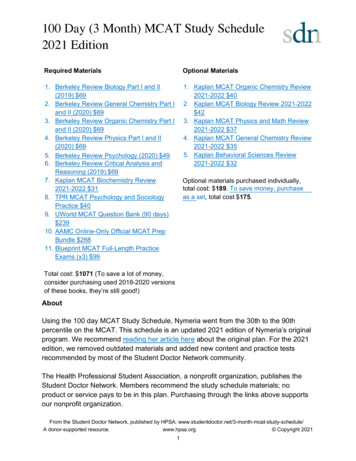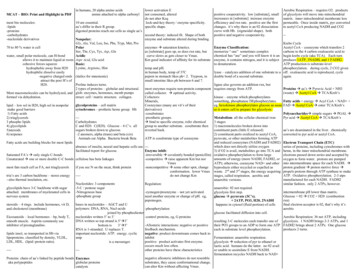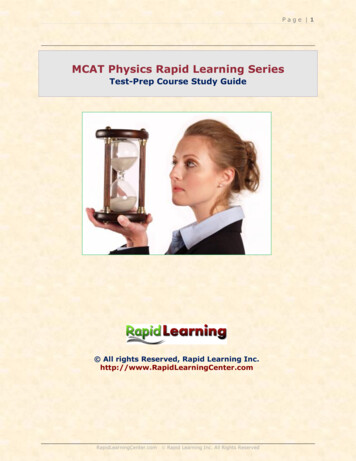
Transcription
Page 1MCAT Physics Rapid Learning SeriesTest-Prep Course Study Guide All rights Reserved, Rapid Learning gCenter.com Rapid Learning Inc. All Rights Reserved
Page 2Table of ContentsCore Unit #1 – The Physics BasicsIn this core unit, you will build the basics to physics mastery. With these skills, you will forma solid foundation to understand physics and problem solving as it applies to the MCAT.Chapter 01: The Guide to Physics MCAT Introduction to the MCATo Definitiono Test formato Test scoring Rapid Learning for MCAT Physics and the MCATo Passage based questionso Stand alone questions Test preparation strategieso Time managemento Planningo Studying hints Test taking strategieso Answer selection hintsChapter 02: Introduction to Physics Definition of physics Metric system Dimensional analysis Measurements and uncertainty Scientific Process Tips for studying physicsChapter 03: Basic Math for Physics Using algebra to solve for a variable Performing calculations with significant figures Using scientific notation Geometry and trigonometry The quadratic formula GraphingChapter 04: Graphing and Error Analysis Cartesian coordinate system Semi log and log-log graphs Random vs. systematic errors Error propagation Mean and standard deviation Gaussian/normal distribution Student t distribution Chi squared testChapter 05: Problem Solving in Physics When to follow problem-solving techniques A general problem-solving technique How to solve word problemsRapidLearningCenter.com Rapid Learning Inc. All Rights Reserved
Page 3 KUDOS methodSURE methodHow to prepare for an examTips for taking examsCore Unit #2 – MechanicsIn this core unit, you will learn the mechanics of motion.Chapter 06: Translational Motion Constant Velocityo Distanceo Displacemento Speedo Velocityo Average Velocityo Constant Velocity Constant Acceleration Definition Formula Units Free Fall Vectorso Definition and notationo Addition of vectorso ComponentsChapter 07: Force and Motion Newton’s Lawso Inertiao Net Forceo Action and reaction forces Resisting Forceso Frictiono Air resistance Dynamics ProblemsChapter 08: Circular Motion and Gravitation Gravityo Formulao Gravitational constanto Gravitational fieldso Gravitational pull at various points on Earth Circular Motiono Linear speed versus rotational speedo Centripetal accelerationo Centripetal forceo Centrifugal forceo Banked roadso Simulated gravityChapter 09: Equilibrium Equilibriumo Statico DynamicRapidLearningCenter.com Rapid Learning Inc. All Rights Reserved
Page 4 o Newton’s second law applicationTorqueo Unitso Directiono ApplicationsMoment of Inertiao Descriptiono Exampleo FormulasRotational EquilibriumChapter 10: Work, Power and Energy Worko Direction of forceo Sign conventions Powero Calculation of power Energyo Kinetic energyo Potential energyo Work energy theoremo Conservation of energy Conservative and non conservative forcesChapter 11: Momentum and Collisions Momentumo Definitiono Formula Impulseo Formulao Exampleso Bouncing versus sticking Conservation of momentumo Collisionso Inelastic versus elastic collisionso 2 dimensional collisionsCore Unit #3 – Waves and SoundIn this core unit, you will learn about the periodic and repeatable nature of waves. Specialattention will be given to sound waves.Chapter 12: Waves and Periodic Motion Simple harmonic motiono Vibrationo Displacemento Amplitudeo Periodo Frequencyo Angular frequencyo Phaseo Uniform circular motiono PendulumsRapidLearningCenter.com Rapid Learning Inc. All Rights Reserved
Page 5 ooWaveoooWaveooooOscillating springsResonancemotionMechanical vs. electromagnetic wavesTransverse vs. longitudinal wavesWave speedsuperpositionInterferenceWave reflectionStanding wavesNodes and antinodesChapter 13: Sound The nature of soundo Our earso Audible and inaudible soundso Speed of soundo Types of waveso Speed of various sounds Properties of soundo Intensityo Pitcho Octaves Beats The Doppler effecto Definitiono Formulao Applications Echoes DiffractionCore Unit #4 – Fluids and SolidsIn this core unit, you will learn about the behavior of two common phases of matter, solidsand liquids.Chapter 14: Fluids Static Fluidso Pascal’s principleo Buoyancy and Archimedes principleo Surface tensiono Capillary action Fluids in motiono Viscosityo Continuityo Laminar and turbulent flowo Bernoulli’s equationChapter 15: Solids States of matter Solids and elasticityo Crystalline materials and their propertieso Amorphous materials and their properties Thermal expansion Deformation of solidsRapidLearningCenter.com Rapid Learning Inc. All Rights Reserved
Page 6 o Young’s moduluso Shear moduluso Bulk modulusApplicationsCore Unit #5 – Electrostatics, Electromagnetism, and CircuitsThe nature, consequences, and movement of charge will be describes in this unit. Thisextends to magnetic phenomena and electromagnetic radiation too.Chapter 16: Electrostatics The nature of electric chargeo Charged particleso Charge movement Charging by contact Charging by induction Electric Forceso Coulomb’s law Formula Exampleso Electric Fieldso Polarization Electric Potentialo Definitiono Unitso Diagramo FormulaChapter 17: Electromagnetic Radiation Electromagnetic spectrumo Types of electromagnetic waveso The nature of EM radiation Speed of light calculationso Roemer’s methodo Michelson’s experiment Transparent vs. opaque materials The greenhouse effectChapter 18: Magnetism Magnetism in natureo Magnetic domainso Ferromagnetismo Magnetic field diagrams Magnetism, force and moving chargeo Right hand ruleo Magnetic field notationo Magnetic force on a current carrying wireo Magnetic force on a moving charged particle Magnetic fluxo Formulao Angleo Unitso Hoop analogyo Example Faraday’s lawRapidLearningCenter.com Rapid Learning Inc. All Rights Reserved
Page 7 o Formulao Induced electromotive forceo ExampleLenz’s lawo Right hand rule applicationo ExamplesElectromotive force in a moving conductorApplicationsChapter 19: Circuit Elements Conductorso Conductorso Insulatoro Semiconductorso Superconductorso Resistance of a piece of wire Capacitorso Definitiono Unitso Diagramo Charge stored in a capacitor Dielectricso Polarizationo Dielectric constantChapter 20: Electric Circuits Ohm’s lawo Circuit diagramso Alternating currento Direct currento Internal resistance Electric powero Formulao Example calculationso Alternating power formulas, rms. Series circuitso Resistors combined in serieso Current and voltage characteristicso Example calculations Parallel circuitso Resistors combined in parallelo Current and voltage characteristicso Example calculations Capacitor combinationsCore Unit #6 – Light and Geometrical OpticsIn this core unit, you will learn about light and its applications.Chapter 21: Light Principle of superpositiono Constructive interferenceo Destructive interference Coherent and monochromatic light Young’s double slit experimento Maxima positionsRapidLearningCenter.com Rapid Learning Inc. All Rights Reserved
Page 8 o Minima positionso Formulaso ExamplesDiffraction gratingso Formulao ExamplesPolarizationo Unpolarized lighto Filterso Malus’ lawChapter 22: Geometric Optics Plane mirrorso Law of reflectiono Virtual imageso Diffuse reflectiono Importance or wavelength Curved mirrorso Concave mirror ray diagramo Convex mirror ray diagramo Mirror equation and exampleo Magnification equation and example Refractiono Index of refractiono Refraction example and analogyo Snell’s lawo Dispersiono Total internal reflectiono Fiber optics Lenseso Convex lens ray diagramo Concave lens ray diagramo Lens equation and exampleo Lens combinationso Lens defectsCore Unit #7 – Atomic and Nuclear PhysicsIn this core unit, you will learn about physics on the very small scale. The nature of theatom and even the tiny nucleus will be explored.Chapter 23: Atomic Physics The discovery of electrons The Bohr model of the atomo Postulateso Radii and energy level valueso Quantizationo Spectrum explanation X rayso Characteristicso Production The wave nature of mattero Particle and wave dualityo Formulas deBroglie hypothesis Heisenberg’s uncertainty principleRapidLearningCenter.com Rapid Learning Inc. All Rights Reserved
Page 9Chapter 24: Nuclear Physics Nuclear compositiono Notationo Forceso Binding energyo Mass defecto Isotopes Radioactive decayo Alpha decayo Beta decayo Gamma decayo Nuclear equations Half life Applications of nuclear scienceRapidLearningCenter.com Rapid Learning Inc. All Rights Reserved
P a g e 1001: The Guide to Physics and the MCATTutorial Summary:The MCAT is a standardized test necessary for all students wishing to gain admission to amedical school. It is now administered as a computer based test instead of a typical penciland paper test. There are two types of questions that may be found. Passage questionscontain a short reading section with related questions. Stand alone questions are withoutany supporting text. You can improve your score on the MCAT by following the studysuggestions outlined in this tutorial. The test taking and test preparation strategies canhelp greatly.Tutorial Features: Detailed outline of test features, schedule, and contents.Concept map showing inter-connections of concepts introduced.Definition slides introduce terms as they are needed.Examples given throughout to illustrate how the concepts apply.A concise summary is given at the conclusion of the tutorial.Concepts Covered: Introduction to the MCATo The “new” MCATo Test formato Test scoringo ScheduleRapid Learning for MCATPhysics and the MCATo Passage based questionso Stand alone questionsTest preparation strategieso Time managemento Planningo Studying hintsTest taking strategieso Answer selection hintsContent Review:MCAT:The Medical College Admissions Test is a standardized exam required to gain admission tomedical school.MCAT CoursesThe new four-section MCAT requires seven college courses – general chemistry, organicchemistry, biochemistry, biology, physics, psychology and sociology. You can either takethese colleges in college or self-study them.Passage-Based QuestionIt is a type of questions relating to information in an accompanying passage. The answermay or may not be in the passage.Discrete QuestionA question that has a topic independent of a passage or other questions with four possibleRapidLearningCenter.com Rapid Learning Inc. All Rights Reserved
P a g e 11answer options.Test Sections(1) Chemical and physical foundations (2) Critical Analysis and Reasoning Skills (3)Biological and Biochemical Foundations (4) Psychological, Social and Biological foundations.General ChemistryMCAT requires students to take two semesters of college-level chemistry for pre-med. Atraditional college course with the mainstream curriculum will cover the scope of the test ingeneral chemistry. The outline style of test prep books might not be sufficient for themastery of general chemistry in MCAT.Computer-based TestMCAT is 100% to be taken on computer with on-screen timer but no calculator provided. Allquestions are multiple-choice now for easy computerized grading. There is no guessingpenalty.ScoringFour sectional scores and one total score with midpoint Chem/Phys Section: 118-132 (midpoint 125) Critical/Reasoning: 118-132 (midpoint 125) Bio/Biochem – 118-132 (midpoint 125) Psy/Social - 118-132 (midpoint 125)Composite Score: 472-528 (midpoint 500)Test Day ScheduleThis is a lengthy exam of 7.5 hours. Chem/Phys: 95 minutes, 59 questions. Critical/Reasoning: 90 minutes, 53 questions. Bio/Biochem: 95 minutes, 59 questions. Psy/Social: 95 minutes, 59 questions.There are 4 sections with 10 minutes break in between.RapidLearningCenter.com Rapid Learning Inc. All Rights Reserved
P a g e 1202: Introduction to PhysicsTutorial Summary:The science of physics describes matter, energy and forces in many respects. To studyphysics many academic tools are needed. The metric system, significant figures anddimensional analysis make measurements and conversions of those measurements easier.These measurements are used with the scientific process to draw conclusions and expandour knowledge of the physical world.Tutorial Features: Step by step easy explanation of example problems: dimensional analysis andsignificant figures.Concept map showing inter-connections of concepts introduced.Definition slides introduce terms as they are needed.Examples given throughout to illustrate how the concepts apply.A concise summary is given at the conclusion of the tutorial.Concepts Covered: The science of physicsThe metric and SI systemso Metric prefixeso SI unitso Common non-SI unitsDimensional analysiso Equalitieso Steps to using dimensional analysisMeasurement and Uncertaintyo Tools common in physics labso Taking measurementso UncertaintySignificant figureso How they’re usedo How to count themScientific processo “The Scientific Method” versus Scientific Processeso Theory versus Lawo Prediction versus HypothesisHow to study physicsContent Review:Physics:This is about the study of the physical world. It’s the science of energy.Metric SystemThe metric system is based on prefixes that indicate a power of 10 with base units.Metric Prefixes commonly used dLearningCenter.com Rapid Learning Inc. All Rights Reserved
P a g e 13CentiMilliMicroNanocm n0.010.0010.0000010.000000001SI systemThe International System of units gives a standard unit for each type of measurement.SI Units terTemperatur KelvineLengthMetersTimeSecondsAmount ofMolesubstanceEnergyJouleChargeCoulombused inSymbolkgLKmsMolJCDimensional analysis:To work dimensional analysis problems: Write your known down on the left side. Write down “ [desired unit]” at the right s
MCAT: The Medical College Admissions Test is a standardized exam required to gain admission to medical school. MCAT Courses The new four-section MCAT requires seven college courses – general chemistry, organic chemistry, biochemistry, biology, physics, psychology and sociology. You can either take these colleges in college or self-study them.


